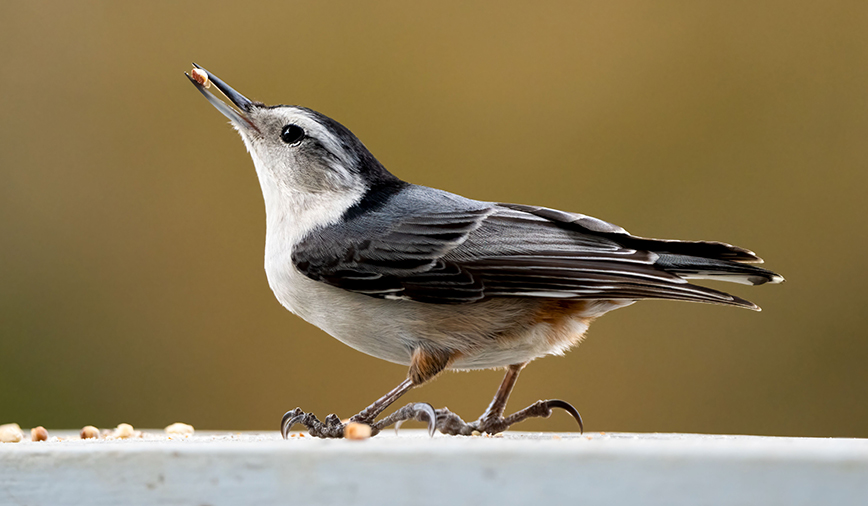December 13, 2013
Nuthatch
Every grade school has one. You know what I’m talking about – the kid who could climb onto the monkey bars and, in one or two deft maneuvers, defy gravity. At our school, it was a boy named Danny. He’d flip and spin; he’d hang upside down; he’d swing with ease from bar to bar.
In short, Danny was a lot like a white-breasted nuthatch.
About the same size as a sparrow, though sleeker in shape, Sitta carolinensis is, first and foremost, an important member of our woodland ecosystems. But it also is one outstanding acrobat. If there’s a tasty morsel at the end of a tree branch, it will swing and sway as much as needed to nab it. If there’s a tasty morsel underneath the branch, it’ll hang upside down to grab it. And if that tasty bit is way low on the tree’s trunk, this talented bird will head down–with the greatest of ease–to stab at it with its narrow, upturned bill.
White-breasted nuthatches are easy to spot just about anywhere there are hardwood trees and, in the winter, bird feeders. Even better, they’re easy to identify. The bird’s namesake white breast is balanced by a blue-gray back and wings; its white head is topped with a black cap that extends down the nape, or neck. Many birds also have a light, rust-colored cast to the feathers on the lower part of the belly and underneath the tail.
At first glance, the white-breasted nuthatch can appear similar to another bird common in our area, the black-capped chickadee. But confusing these two birds is like getting Santa Claus
mixed up with Father Christmas. The differences are significant, if you just know what to look for.
For one, chickadees’ black caps extend below their eyes, and are accessorized with a black throat patch. The white-breasted nuthatch’s black “cap” is really more of a toupee. It covers only the top of the head and neck; the bird’s facial feathers are white
Another difference is in the birds’ bills. Chickadee bills are short and pointy, just right for carrying away small bits of wood as the bird excavates a nest. They also do a good job of pecking away at seed husks and nutshells.
In comparison, the white-breasted nuthatch’s bill is longer and thinner. It can “hatch,” or peck open, nuts and seeds but is not used for homebuilding. Instead, white-breasted nuthatches shop around for ready-made homes – cavities already created by chickadees or woodpeckers.
Then there’s that distinctive nuthatch trait – the one that makes them the daredevil acrobats of our local woodlands: They hop down tree trunks face first. That’s right, upside down. Just like Danny.
Although many local birds forage on tree trunks, only nuthatches glean with their head pointing downward. It’s a behavior unique to the genus, and one that’s unmistakable. And as any birder will tell you, unmistakable identifying characteristics are invaluable, no matter what the species. (Note: Red-breasted nuthatches also occur in Kane County, in winter, and display this same head-down behavior. But because they’re typically associated with conifers, their distribution is limited. Count yourself lucky if you see a red-breasted nuthatch.)
White-breasted nuthatches occupy a broad niche in our local ecosystems. They feed on insects as well as seeds. In fact, many people first become acquainted with this bird when it visits a feeder to feast on two of its favorites, peanuts and sunflower seeds.
But it’s in its natural habitat, our oak-hickory woodlands, that this bird really shines. There you can watch them flit from branch to branch, often hanging upside down as they poke and prod in search of food.
If you’re looking for a locally common bird species with supreme acrobatic talents – and you know you are – the white-breasted nuthatch is the bird for you.
Pam Otto is the manager of nature programs and interpretive services at the Hickory Knolls Discovery Center, a facility of the St. Charles Park District. She can be reached at 630-513-4346 or potto@stcparks.org.

